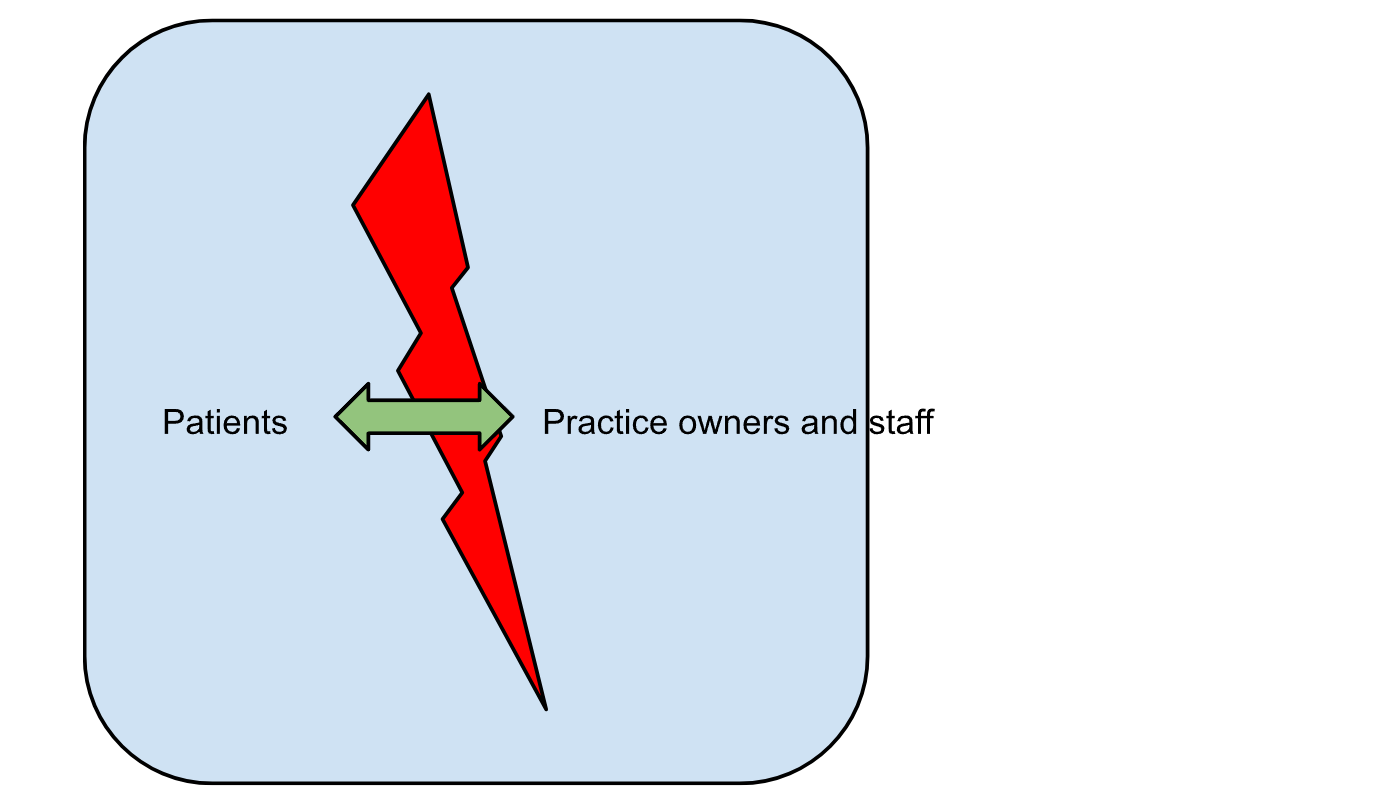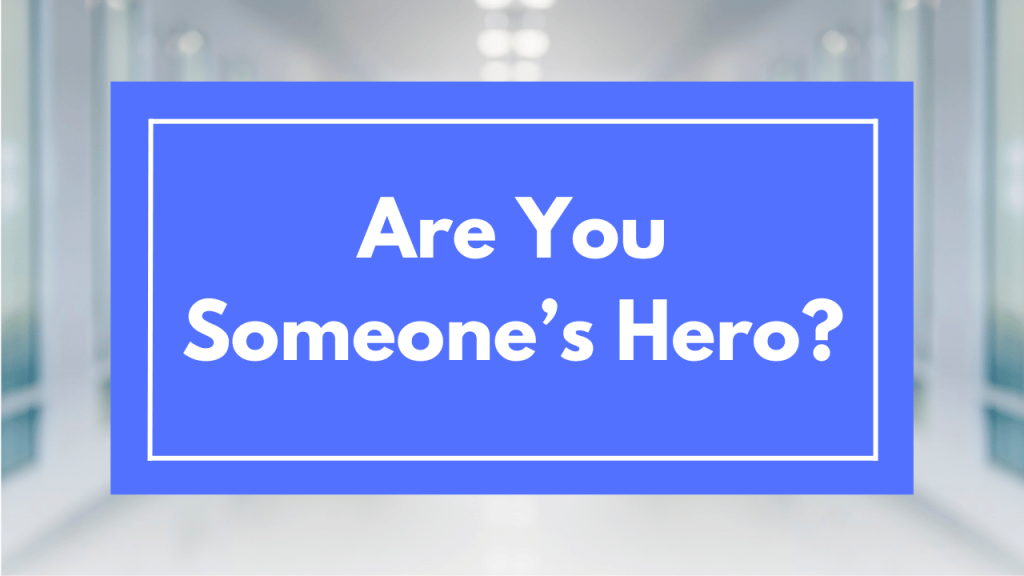In the last chapter we talked about hunger and the drive that must exist between all members of a patient community, including the patients themselves, but what about the patient’s need for a mentor? Remember in previous chapters we talked about how Joseph and Bonnie’s dispositions not only affected their ability to treat effectively but also resulted in lost patients? Patients, because they are people, respond and react to the emotions they receive. We don’t always react in the expected way, but that has more to do with the person interpreting than the person reacting. So how do we set ourselves up so that when we aren’t having the best day ever and performing at our peak state, our patients still receive the best care possible?
The answer is heroism. And no, I’m not talking about superhero heroism like we see in the movies today. I’m talking about the heroism of someone behaving in a consistent and positive way that inspires others. When people see someone working harder than everyone else (and I don’t mean slightly harder, I mean orders of magnitude harder), they naturally want to help that person. Following success is a tremendous motivator for many because it means that they don’t have to expect 100% effort from themselves to achieve a goal. In other words, the responsibility isn’t 100% on them, and so they feel compelled to work as hard as possible, if not harder.
We all know the power of heroes in fiction and how they inspire their comrades and even enemies, in many cases, to follow the path of good and righteousness. Take the most famous superhero of them all. Superman. As we prepare for the dawn of the Superman movies in cinema, these films raise powerful questions about what is meant by a leader. Many would say that Superman is an example of a great hero, but I would disagree. Superman is a great character and, in fiction, does amazing things for many. However, because his power is so great and far removed from our own, we don’t feel like what he does is ever enough (hence people never truly appreciate Superman except when their lives are on the line).
As practice owners and clinicians, we’re often seen this way. We hold in our minds and hands, the ability to create massive change in a patient’s life, change that that patient would otherwise be unable to experience. This truly defines us as Superheroes, but it also presents a major problem. It means we are too far removed from our patients resulting in this kind of detached relegation. We feel compelled as patients to receive care and do so reluctantly, hoping we never need to return (think about it, how many patients truly want to be thinking about their illness?).
Now take the example of the practice owner and how we react when we feel like superheroes. Sure, at the beginning, it’s an incredible ego booster, it makes us feel like we are kings and invincible. But then what? The feeling goes away, and we’re left with a patient roster that, quite frankly, is embarrassing by superhero standards. Naturally, this gives way to the feeling of inadequacy and negativity we discussed earlier. So what do we need to do? Simple (but not easy), we need to get closer to our patients. In other words, we need to close as much of the rift between a patient and their physician as possible. Since this is a natural phenomenon with man-made side effects, it is especially difficult to resolve. It means that we, as practice owners, have to first overcome our confidence needs to see ourselves as our patients see each other, powerful and capable.

Above is a diagram that describes what I’m talking about. Nature develops these build-in separations as we grow in expertise and capability, but it also creates a lack of empathy and connection with our patients. The real question is, who is responsible for bridging this gap?
Heroism lies in effective communication with patients and addressing their concerns holistically. As a practitioner, you should be able to listen to, understand, and share in people’s feelings, beliefs and experiences in order to take care of their real needs and offer individualized care rather than just focusing on the science of the illness. This is part of the spectrum of empathetic communication (Moudatsou et al, 2020). Several strategies can be used to effectively communicate with patients. These include active listening, using plain language while avoiding technical jargon, using relatable examples and illustrations, using appropriate language, keeping the interaction confidential and letting patients explain concepts in their own words to demonstrate understanding. (Tulane University School of Public Health and Tropical Medicine. Strategies for Effective Communication in Health Care. Sept 2021; Float Care 2023 )
Here’s a great personal example. In graduate school, I was a teacher’s assistant (professor lackeys or TAs as we were widely known) teaching the recitation for a course on statistics for Psychology undergraduate majors. These were first-year students who, for the most part, had no idea what they were doing, but also knew exactly what they were doing. As with most young people, there was a split, and although they needed guidance, they weren’t ready to admit it yet. This was clear in the first month as I clearly entered the room as an authority figure. I was confident in my knowledge of the material and ability to convey it in a manner that would instruct students (sounds engaging, doesn’t it?). Obviously, you can imagine what happened next: I inspired exactly zero students to actually be interested in the material and as a result, many did not pass the first exam. There was an uproar from the professor and from the students, apparently thinking that the recitations were the source of the problem.
The professor sat me down for an hour over coffee and tea (I was the difficult one who didn’t and still doesn’t drink coffee), explaining the difference between talking at and engaging with students in a recitation. What a difference that made! Within just a few classes, the students were asking good questions, engaging in the material, and doing very well on exams. And this was statistics!
In reality, both the patient and practice owner must do this together; however, as the practice owner, it’s our responsibility to consistently reach out to do so. The reason for this is simple: You know, and they don’t. Patients don’t read about how to become better patients, they’re focused on their own careers, families, wants and desires. This means that we as practice owners, must both reach out to our patients and expect the same from our staff.
A good practitioner should take the time to actively listen to their patients and address their concerns. Patients will feel cared for when their physician maintains appropriate eye contact and actively listens to them while avoiding unnecessary distractions such as mobile phones or computers. It also makes it possible to identify the patient’s main concerns. Take for instance, you see a patient and book them for an MRI the following day. You mention that to them while you are on the phone consulting about another case. You do not pick up the uneasiness and worry on your patient’s face upon mention of MRI. They don’t show up for the MRI the following day, and it is only a month later that they come with complications. When you ask to establish why they did not show up, they cite fear of exposure to ionizing radiation. Unfortunate, isn’t it? This could simply have been avoided by maintaining eye contact and picking up the worry in the patient’s face earlier. A simple probing could have revealed their worry, and you could have helped the situation by reassuring them that MRI imaging does not put them at risk of exposure to dangerous ionizing radiation.
A hero in the eyes of the patient is a practitioner who uses relatable language and examples while avoiding jargon. Say you are attending to a mother who has a premature neonate with respiratory distress of the newborn. She is concerned about the ailment of her child. A good relatable example of this condition would be a comparison of blowing two balloons, one flat and another partially inflated. Explaining to the mother how it is more difficult to fill a flat balloon compared to a partially filled balloon. This would correlate with the lung collapse associated with respiratory distress of newborns that makes it difficult to breathe in. Such relatable examples make clients understand their conditions better, improving the care outcomes.
Every interaction with patients should also be done in an appropriate quiet, and confidential space since the information disclosed to us is often personal. Keeping the conversation private and confidential while avoiding unnecessary ears inspires confidence and makes our patients feel easy discussing their concerns.
When we’re able to connect with our patients and bridge this schism, we create something different from a superhero, but more valuable: A Hero. A hero is someone who, regardless of innate ability, makes consistent efforts that create massive change, and inspire others to follow in their footsteps. This is, in my opinion, more powerful than a superhero because it requires more than natural ability; it requires a different kind of genius that, unlike natural ability, is learnable. We can actually learn and train to become geniuses in a way that both serves us and helps others; it’s truly a win-win. Now that we understand how to be a patient’s hero, let’s talk about how we can get those patients to see us as heroes in the first place.
References
Moudatsou M, Stavropoulou A, Philalithis A, Koukouli S. 2020. The Role of Empathy in Health and Social Care Professionals. Healthcare (Basel). 8(1):26.
Tulane University School of Public Health and Tropical Medicine. Sept 2021. Strategies for Effective Communication in Health Care. Link: https://publichealth.tulane.edu/blog/communication-in-healthcare/
FloatCare. 2023. Effective Communication Strategies for Healthcare Professionals. Link: https://www.floatcare.net/post/communication-strategies-for-healthcare-professionals
A Future Book Publication Note:
This article is a chapter in the forthcoming 2nd Edition book “Medical Billing Networks and Processes,” authored by Dr. Yuval Lirov and planned for publication in 2024. We will post more chapters on this blog soon.


